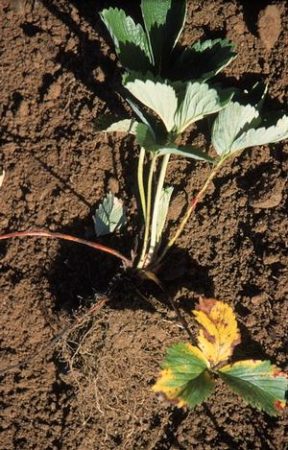Post category: Strawberries
Varieties
Two established strawberry varieties are ‘Cambridge Favourite’ which has been around for decades, and ‘Elsanta’ which is more recent but well established too. ‘Cambridge Favourite’ is a robust plant with solid rounded fruit, while ‘Elsanta’ has smaller fruit of better flavour. Other varieties that might be offered include ‘Hapil’ with large fruits, ‘Honeoye’ with good flavour and heavy cropping and ‘Symphony’, which is a late cropper and extends the season.
Planting
Strawberries must have full sunshine and an open, airy position. Being low-growing, they can tolerate a reasonable level of wind exposure. Strawberry flowers are sometimes killed – turned black at the centre – by late frost, especially in inland areas and cold districts. Avoid planting in a frost pocket – a low lying area at the bottom of a slope.

’Elsanta’ strawberrries
Good, fertile, well-drained but moisture-retentive, slightly acid soil is the ideal for strawberries. It must be well-drained because the plants will suffer from fatal red core and crown rot diseases in water-logged soils.
Poor soil can be made improved by applying organic manures and fertiliser. Limy soil is fine, as long as it is well-drained. The ground should be completely free of perennial weeds before planting.

Well-rooted strawberry runner for planting
Plant healthy strawberry runners. If purchasing new stock, buy plants that are Department of Agriculture certified free from disease and pests. Space the plants about 35 – 45 centimetres apart, in rows about 75 centimetres apart. Plant them so that the crown – where the roots and leaves meet – is at soil surface level.
Care after planting
Strawberries must be kept free of weeds, with which they cannot compete. Hand weed around the plants and hoe the alleyways. Planting through a layer of black polythene is sometimes used to prevent weeds and keep the fruit clean.
Pick the fruit when it is ripe – not before – it will not ripen off the plant. After picking is finished, cut away all the leaves and unwanted runners. Remove any weeds that are present. At full cropping, each plant may give up to 500 grams of fruit.
Every spring apply 70 grams of general fertiliser per square metre. On heavy, limy soils, replace this with 35 grams of sulphate of potash per square metre, to prevent excessive leafiness.
Replanting should be carried out every second or third year. If the plants are left any longer, the fruit size gets smaller, and there is a likelihood of pest or disease build-up.
New plants can be planted in early autumn each year, either purchased or raised from runners. The runners should be pinned down in June to give strong plants to lift in August/September, planted 30cm apart and ripped out when they have given runners the following year. This is a way to keep a stock of young plants with large, quality fruit.
Pests and diseases
Greenflies usually appear in April or May and build up quickly. Apart from weakening the crop, they bring virus diseases that render the plants useless. Control will be necessary.

’Cambridge Vigour’ strawberries
Slugs and snails eat the ripe fruit and may destroy a big proportion of the crop in a wet year. Take precautions.
Birds, in particular blackbirds and thrushes, eat the ripe fruit. Netting is the only answer.
Mites, especially red spider mites, may stunt the crop. Control is not easy and it is best to destroy affected plants.
Eelworms get into the crowns and leaves and cause stunting. There is no cure, destroy affected plants. Vine weevil grubs bore into the crowns below soil level and cause reddening of leaves, poor growth and death of plants. Remove and burn plants affected by eelworms or vine weevils.
Grey mould of the fruit is the main disease. It is worst in a wet summer and on older plants where there is inadequate air movement. Improving air movement is the main method of control. Affected fruit should be removed to reduce spread. Spraying with systemic fungicide when the first flowers open is also possible but generally not carried out in a home garden.
Virus diseases of several kinds are spread by greenflies. Affected plants are stunted, show yellow markings and crop poorly, if at all. They should be removed and destroyed.


